中医英语翻译的特点
中医术语汉译英的基本方法
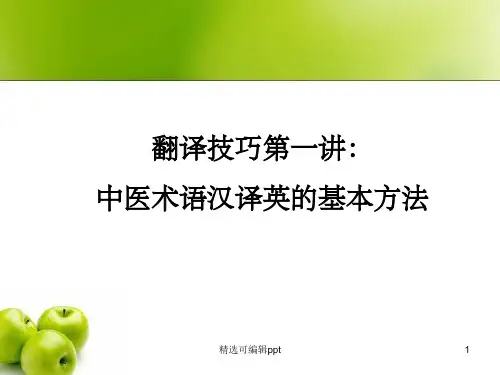
精选可编辑ppt
1
在中医翻译实践中,中医术语的翻译是核心、 是首要。这就是说,要与国外医学界交流信息, 要使译文能顺利地为外国读者理解,我们首先要 能准确地翻译中医术语. 进而达到准确完整地翻 译中医、中草药等专著、专文的目的。以下是中 医术语英译的几种基本方法。
2)一些相关疾病、症状 由于大多数疾病的人体表现都具有普遍性,中医描 述相关疾病或症状的术语也可以直接翻译成相应的英语
精选可编辑ppt
4
词语。如:
头晕目眩 耳鸣目涩 心悸心烦 失眠健忘 鼻衄
headache and vertigo tinnitus and dryness of eyes vexation and palpitation insomnia and poor memory; nose bleeding
采用意译的手法则可以得其“意义”而不拘泥于“字
精选可编辑ppt
9
面”。
因而,我们应该将金、木、水、火、土意译为lung,
liver, kidney, heart, spleen, 而不是译成metal,
water, fire, earth.
“木火刑金”可意译成liver fire impairing lung. 如
直
精选可编辑ppt
7
接译为gynecologist.
二.意译
意译(free translation) 是指根据原文的大意
来翻译,不作逐字逐句的翻译。意译只保持原文内
容,不保持原文形式。 在中医术语翻译实践中,意译就是指根据名词术
语所表示的具体事物或概念,不拘泥于字面意义的 翻译。
意译的实用对象是:
10
中医英语翻译特点略谈

中医英语翻译特点略谈作者:丁冲彭锐邹阳来源:《中国民族民间医药·下半月》2012年第05期【关键词】中医;英语翻译【中图分类号】R2【文献标识码】A【文章编号】1007-8517(2012)10-0027-01近年来,中医越来越受到世界各国人民的欢迎和关注,但世界各国学习中医的学生,受英译资料的限制,无法获得充足的信息,在中医英译中存在的“乱译”、“误译”现象,给人们造成了误解,也阻碍了中医的发展,制约了中医走向世界的步伐。
因此,规范中医英译工作就显得迫在眉睫了。
翻译虽重在实践,但也离不开理论的指导,在现行的中医翻译活动中,许多译者往往借助诸如汉英中医辞典或手册,加上自已的理解和习惯去释义和翻译,而不是按照翻译学的基本原理和实际要求来再现原文信息,离“信、达、雅”的标准相距甚远。
大部份译者是不懂专业的英语翻译工作者或是懂中医但缺乏翻译技巧和外语文化背景知识的中医医生,他们不重视其译语是否合情(中医的实际情况),是否合理(翻译的理论),造成中医翻译界存在种种混乱现象。
例如“气”是中医学中最常见的词之一,它既有功能之“气”,也有物质之“气”,还有精气、宗气、元气、真气、营气、卫气等等。
有的词典把它翻译为“en-ergy”,有的译成vital energy,还有的译成“Qi"。
而energy根本无法表达中医“气”的内涵。
再如“心开窍于舌”有如下译法:The heart opens into the tongue;The t0ngue is theorifice to the heart;The heart ppens to the t0ngue.the tongue asthe window of the heart;The heart has its specific body openingin thetongue;The heart reflects0nthet0ngue.按中医的原意,“心开窍于舌”就是说心脏的一些生理和病理状况在舌头上有所反映,医生通过观察患者舌的变化对心脏做出诊断。
中医英语翻译的原则分析
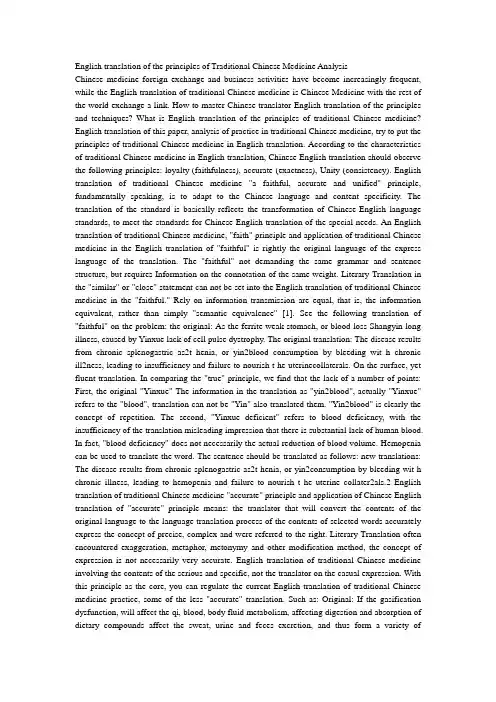
English translation of the principles of Traditional Chinese Medicine AnalysisChinese medicine foreign exchange and business activities have become increasingly frequent, while the English translation of traditional Chinese medicine is Chinese Medicine with the rest of the world exchange a link. How to master Chinese translator English translation of the principles and techniques? What is English translation of the principles of traditional Chinese medic ine? English translation of this paper, analysis of practice in traditional Chinese medicine, try to put the principles of traditional Chinese medicine in English translation. According to the characteristics of traditional Chinese medicine in English translation, Chinese English translation should observe the following principles: loyalty (faithfulness), accurate (exactness), Unity (consistency). English translation of traditional Chinese medicine "a faithful, accurate and unified" principle, fundamentally speaking, is to adapt to the Chinese language and content specificity. The translation of the standard is basically reflects the transformation of Chinese-English language standards, to meet the standards for Chinese-English translation of the special needs. An English translation of traditional Chinese medicine, "faith" principle and application of traditional Chinese medicine in the English translation of "faithful" is rightly the original language of the express language of the translation. The "faithful" not demanding the same grammar and sentence structure, but requires Information on the connotation of the same weight. Literary Translation in the "similar" or "close" statement can not be set into the English translation of traditional Chinese medicine in the "faithful." Rely on information transmission are equal, that is, the information equivalent, rather than simply "semantic equivalence" [1]. See the following translation of "faithful" on the problem: the original: As the ferrite weak stomach, or blood loss Shangyin long illness, caused by Yinxue lack of cell pulse dystrophy. The original translation: The disease results from chronic splenogastric as2t henia, or yin2blood consumption by bleeding wit h chronic ill2ness, leading to insufficiency and failure to nourish t he uterinecollaterals. On the surface, yet fluent translation. In comparing the "true" principle, we find that the lack of a number of points: First, the original "Yinxue" The information in the translation as "yin2blood", actually "Yinxue" refers to the "blood", translation can not be "Yin" also translated them. "Yin2blood" is clearly the concept of repetition. The second, "Yinxue deficient" refers to blood deficiency, with the insufficiency of the translation misleading impression that there is substantial lack of human blood. In fact, "blood deficiency" does not necessarily the actual reduction of blood volume. Hemopenia can be used to translate the word. The sentence should be translated as follows: new translations: The disease results from chronic splenogastric as2t henia, or yin2consumption by bleeding wit h chronic illness, leading to hemopenia and failure to nourish t he uterine collater2als.2 English translation of traditional Chinese medicine "accurate" principle and application of Chinese English translation of "accurate" principle means: the translator that will convert the contents of the original language to the language translation process of the contents of selected words accurately express the concept of precise, complex and were referred to the right. Literary Translation often encountered exaggeration, metaphor, metonymy and other modification method, the concept of expression is not necessarily very accurate. English translation of traditional Chinese medicine involving the contents of the serious and specific, not the translator on the casual expression. With this principle as the core, you can regulate the current English translation of traditional Chinese medicine practice, some of the less "accurate" translation. Such as: Original: If the gasification dysfunction, will affect the qi, blood, body fluid metabolism, affecting digestion and absorption of dietary compounds affect the sweat, urine and feces excretion, and thus form a variety ofmetabolic disorders. The original translation: The disorder of qi activity can affec t themetabolism of qi, blood and body fluid, affect t he digestion andabsorption of food, and affect sweating, urination and defeca2tion, resulting in various metabolic diseases. Translation will appear in the original three " impact ", all translated, appeared stiff, does not meet the language used in English. To avoid these problems, according to the actual semantics of the original three synonyms were used to translate "impact", affect, impair, inhibit accurate expression of the concept of a complete solution to the problem. The sentence should be translated as follows: new translations: The disorder of qi activity can affect themetabolism of qi, blood and body fluid, impair t he digestion andabsorption of food, and inhibit t he excretion of sweat, urine andfeces, resulting in various metabolic diseases. Chinese English translation of "accurate" principle embodied in the choice of words on the first. And accurate selection of translation words is based on correct understanding of the original. More than just the choice of words from English dictionary to find the corresponding words only. It reflects the translators of the Chinese medicine knowledge and understanding of the depth of Chinese-English bilingual glossary. For example: Original: Semi-pin, one of the ancient practice of acupuncture, which is characterized as a shallow stab and was only half the normal depth, a needle quickly. Translation: "Half2needling" is one of the ancient needingmanipulations, characterized by shallow needling at only halft he usual dept h wit h quick wit hdrawal. Chinese term "acupuncture" in a different mix of English have different expressions. needling is a common translation, acupuncture, and puncture for the more formal concepts such as acupuncture (acupuncture), acupuncture body position (acupuncture pos2ture), acupuncture anesthesia (acupuncture anest hesia), acupuncture (acupuncturet herapy) and so on. This translation, according to the principle of an accurate choice of English words, choose the needling. Translation, only in accordance with its connotations of "accurate" choice of English words in order to ensure that information and concepts of the corresponding conversion. Sometimes, the original lacks accuracy, according to the translator if the original hard-translation, translation will inevitably lead to ambiguity. In this case, the translator also responsible for the verification of the original concept, to determine the original meaning of the task. English Translation of the many errors in traditional Chinese medicine seems to be caused by the original. Some of the original concept and expression does not give rise to misunderstanding the original readers, but the literal translation in the past may make the reader misunderstanding. Only to verify the original translator, accurate translation, translation will reduce the ambiguity. For example: Original: its symptoms of cold and heat exchanges, Xiong Xie bitter full, upset hi vomit quietly do not want to diet, mouth pain throat, dizziness, pulse string and so on. PRESIDENT: Its topical symptoms are alternative chills and fever, hypochondriac and t horacic stuffiness, irascibility, frequent hic2cups, depression, poor appetite, somatic bitterness, dry t hroat, blurred vision and a tense pulse. Text used the word "bitter Xiongxie Man" The term "hard over" to describe the extreme discomfort Xiongxie sense of fullness, vague concepts, translation using the stuffiness, general translation of this concept, so that the original fuzzy get an accurate translation. Chinese English translation of "accurate" principle, the main text and the translation is to provide an accurate flow of conceptual terms, but does not require the wording and Structure of the corresponding surface. To achieve translation of "accurate", the translator should be a solid way to learn Chinese and English language expertise. Similarly, a concept in a different language environment requires a different expression. Translator grasp the translation of "accurate" is just to the original text in translation smooth and appropriate. The general literature on Chinese-English translation, the translator often from an entry on theChinese-English dictionary effectively to find a few translations, a brief screening requirements can be selected. Traditional Chinese medicine is definitely not like the English translation of Chinese-English dictionary from the options that simple. The translator must be based on traditional Chinese medicine expertise to make a choice of English, some word equivalent on the surface actually is a big difference. Some English words, the translator that can translate a text for the concept, but the reader is asked not understand. Chinese English translation of the concept of more stringent limits, but also to the translator's knowledge of languages other than put a higher demand. Meet the need for a translator is only a general understanding of the English word, is far from the English translation of Chinese medicine practitioners, Chinese English translation must be consistent with the needs of English readers. The translator can make the right choice is the key not only to be familiar with traditional Chinese medicine and Chinese, but also be familiar with traditional Chinese medicine in English. 3 English translation of traditional Chinese medicine "unified" principle and the use of TCM English translation of "unity" principle, which is Chinese-English translation of terminology in the translation process at all times should maintain a unified, does not allow arbitrary transformations of the same terminology translation. Of course, Chinese English translation of the "unified" principle to some extent dependent on the concerted efforts of the translator as well as the general authority of department of uniform provisions. Some words in his popularity is often the initial cause trouble to the translators. In the end these words to what to say, really easy, so the translator had to demonstrate their individual had. Such as the Chinese term "triple burner" had been variously translated: triple energizer, tri2energizer, the Sanjiao, the warmers, the heaters and so on. Such non-uniform phenomenon, so that we spend much effort to understand the relevance of the various translations. The World Health Organization promulgated "acupuncture meridians of the International Standardization Program" will "triple burner" be translated as triple energizer, we should be internationally harmonized standards in accordance with this translation. With the "unification" of the translation, Chinese English translation could not be easier. At the same time, maintaining the unity of translation is also to facilitate readers in understanding and smoothly convey information. The principle of unity should be the English translation of traditional Chinese medicine and international bi-directional integration [2]. English translation of traditional Chinese medicine to maintain translation of the term "reunification" There are three ways: (1) with reference to international TCM English monographs and literature, such as the World Health Organization promulgated the "acupuncture meridians of the International Standardization Program" and so on, to keep Chinese English nouns Chinese-English translation of the term unity, international and stability. (2), the most authoritative reference to the new Chinese medicine Chinese-English dictionary. (3) The terms and expressions in English translation must be a long time that people use, the basic convention only after unification. Chinese-English translation of traditional Chinese medicine Chinese medicine is the most difficult terms and phrases properly translated into English, the translator must study harder, continue to read Chinese at home and abroad in English magazines, to grasp the translation movement. Professional Chinese-English Dictionary in English, traditional Chinese medicine field has a strength and authority of the translation has been convention, we should be consciously applied to our translation practice. Some translation is not perfect, but the translator for the time being follow these conventions translation. Because they followed the use of English translation of the long-standing, forming a fixed term, the best of their first with him. To introduce new, not a translator can call the shots, nor is it overnight, need long-term effort [3]. In short, thetransmission of information because of TCM English with the special nature of the existing principles and standards of the various translations is not very appropriate English translation of traditional Chinese medicine, the authors propose a "faithful (faithfulness), accurate (exactness), Unity (consisten2cy)" The English translation of the principles of traditional Chinese medicine, with a view to some standard English translation of Chinese medicine. This principle should be to return to English translation in the practice of traditional Chinese medicine to be tested. [References]1 Li Zhao-guo. TCM English translation techniques [M]. Beijing: People's Health Press, 1997.123.2 Lei Luo. Modern Chinese medicine Chinese-English translation skills [M]. Beijing: Chinese Ancient Books Publishing House, 2003. Chen Keji preamble.3 Xie Zhu-fan. With regard to the English translation of TCM terminology discussion [J]. Chinese Journal of Medicine, 2000,20 (9): 7062709中医英语翻译的原则分析中医药对外交流和商务活动日益频繁,而中医英译则是中国与世界其他国家中医药交流的一条纽带。
中医药翻译技巧综述
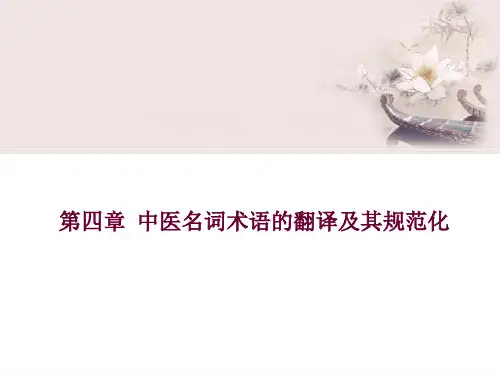
•
脏象学说方面 脉:vessel, pulse 宗脉:converging meridians, assembled meridians 胞衣:placenta 空窍:hollow orifices 七冲门:seven important portals 四海:four convergence 心主神明:heart controlling the mind 心合小肠:the heart associated with the small intestine 心开窍于舌:the heart reflected on the tongue the heart is (as) the signal orifices of the tongue 心,其华在面:the heart flourishing on the face
中医名词术语的翻译原则
• 民族性原则
中医学在思想原则、概念范畴等方面都有自身独到的规定 性;在观念系统、理论系统与操作系统方面,都有与现代 医学强烈的不可通约性。所以就文化特征而言,中医学还 只是中华民族特有的医学体系,因而具有鲜明的民族性。
中医名词术语的翻译原则
• 回译性原则
“回译性”指的是英译的中医名词术语在结构上应与中文形式相近, 这样在中医药的国际交流中,就能较好地实现信息的双向传递。 对回译性的追求以不影响信息的再现为前提。 受盛之腑:hollow organ in charge of reception → small intestine 传导之官:official in charge of transportation → large intestine
•
脏象学说方面 脏象:state of viscera, visceral manifestation 脏象学说:theory of visceral manifestation 脏腑:zang and fu, viscera 五脏六腑:five zangs and six fus 藏而不泻:storage without excretion 泻而不藏:excretion without storage 心包络:pericardium 三焦:triple energizer, sanjiao 命门:mingmen, the gate of life/vitality, vital gate, vitaport 奇恒之腑:extraodinary fus
医学英语-词汇翻译2017
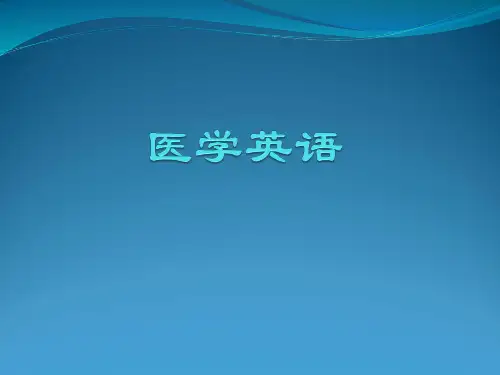
定语从句的翻译
合译法 The intestinal flora produces ammonia and other breakdown products which are absorbed and can contribute to hepatic coma. 译文:肠内菌丛能产生可被吸收并能引起肝昏迷的氨 和其他分解产物。
这种方法称为合译法。
The intestinal flora produces ammonia and other breakdown products which are absorbed and can contribute to hepatic coma.
intestinal英 [ɪnte'staɪn(ə)l; ɪn'testɪn(ə)l]美 [ɪn'tɛstɪnl]adj. 肠的 flora[‘flɔrə]n. 植物区系;植物群复数 floras或florae ammonia英 [ə'məʊnɪə] 美 [ə'monɪə]n. [无化] 氨,阿摩尼亚 hepatic英 [hɪ'pæ tɪk] 美 [hɪ'pæ tɪk]adj. 肝的;肝脏色的;治肝病的 coma英 [‘kəʊmə] 美 [’komə]n. [医] 昏迷;[天] 彗形像差
译文:绝大多数㡯的死因是由于大面积皮肤(被)烧 伤而使机体重要功能受到破坏。
Typhoid fever is frequently transmitted by human carriers.
译文:伤寒常常由(被)带菌者传播。
typhoid英 [‘taɪfɒɪd] 美 [’taɪfɔɪd]adj. 伤寒的;斑疹伤寒症的n. 伤寒
否定句的翻译
浅谈中医翻译
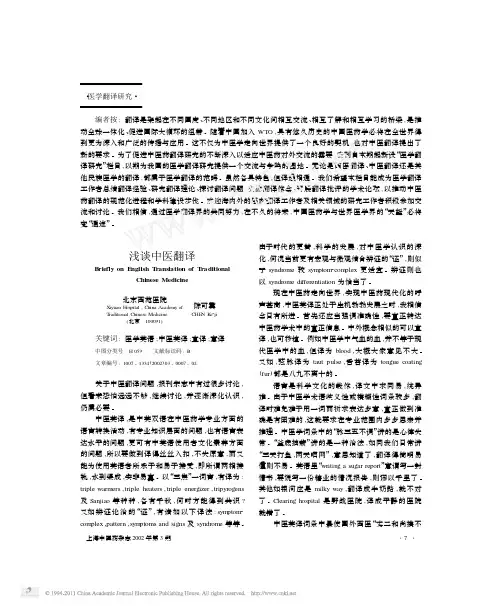
・医学翻译研究・ 编者按:翻译是架起在不同国度、不同地区和不同文化间相互交流、相互了解和相互学习的桥梁,是推动全球一体化、促进国际大循环的纽带。
随着中国加入WTO,具有悠久历史的中国医药学必将在全世界得到更为深入和广泛的传播与应用。
这不仅为中医学走向世界提供了一个良好的契机,也对中医翻译提出了新的要求。
为了促进中医药翻译研究的不断深入以适应中医药对外交流的需要,我刊自本期起新设“医学翻译研究”栏目,以期为我国的医学翻译研究提供一个交流与争鸣的园地。
无论是西医翻译、中医翻译还是其他民族医学的翻译,都属于医学翻译的范畴。
虽然各具特色,但译理相通。
我们希望本栏目能成为医学翻译工作者总结翻译经验、研究翻译理论、探讨翻译问题、交流翻译体会、开展翻译批评的学术论坛,以推动中医药翻译的规范化进程和学科建设步伐。
欢迎海内外的医药翻译工作者及相关领域的研究工作者积极参加交流和讨论。
我们相信,通过医学翻译界的共同努力,在不久的将来,中国医药学与世界医学界的“天堑”必将变“通途”。
B riefly on E nglish T ranslation of T raditionalChinese Medicine北京西苑医院X iyuan H ospital,China Academy ofT raditional Chinese M edicine(北京 100091) 陈可冀CHE N K e2ji 关键词:医学英语;中医英译;直译;意译 中图分类号:H059 文献标识码:B 文章编号:1007-1334(2002)03-0007-02 关于中医翻译问题,报刊杂志中有过很多讨论,但看来恐怕远远不够,继续讨论,并逐渐深化认识,仍属必要。
中医英译,是中英双语在中医药学专业方面的语言转换活动,有专业知识层面的问题,也有语言表达水平的问题,更可有中英语使用者文化素养方面的问题,所以要做到译得丝丝入扣,不失原意,而又能为使用英语者所乐于和易于接受,即所谓两相接轨,水到渠成,实非易事。
中医药语言的特点及英译中的常见障碍
以上 提 到 的都 是 人 身之 气 , 中 医还 将 中药 的 四种 性 质 称 为“ 四气 ” , 将 自然 界六 种 不 同气 候 变化 称 作“ 六 气” ,将 体 内不 正常 的水 液称 作“ 水气” , 将 致病 的六淫称 为“ 邪气 ” 。仅“ 气” 就有 如此 多 的相 关概 念 , 且 意义上 各不 相 同 。 中医药 语 言的抽 象性 和 复杂 性给 翻译 实践 带来 了巨大挑 战 。 1 . 2 人文- 性与 文学性 一直 以来 , 人 们 都将 医 学 视 为 自然科 学 。而 实际 并非 如此 , “ 医学 在具 有 显 著 自然 科 学性 质 的 同时 , 还 具 有显 著 的 人 文科 学
文形 式存 在 , 语 言上表现 出浓 厚 的古典 文学 色 彩 , 这给 中 医英译 带来 了诸 多 障碍 。全 面 掌握 中 医药 语言 特 点 , 客观 分 析其对 英 译造 成 的障 碍 , 有助 于 顺 利 开展 中医英语 翻译 工 作 , 促进 文 化交 流 。
里特 有 的抽象 概 ‘ 三焦” , ( ( 灵枢 ・ 营卫 生会》 篇 中 运用 比喻 手法 对其 功 能作 出 了形象 的概 括 , “ 上 焦 如雾, 中焦如 沤 , 下 焦 如渎 。 ” “ 上 焦如 雾 ” , 形容 上
而成 的 一种 医学 理论体 系 。中医经 典 著作 多 以古
性 质 ] , 这 在 中医药 学上 的表 现尤 为 明显 。中医 药语 言非 常 重 视 取类 比象 的 方法 , 还经 常 运 用 比 喻 等 多种 修 辞 手 法帮 助 阐释抽 象 概 念 , 使 其 变 得
中医英语翻译的心得体会
中医英语翻译的心得体会中医作为中国的传统医学,拥有悠久的历史和丰富的理论。
中医有着与西医不同的术语和语言表达方式,因此在进行中医的英语翻译时需要注意一些事项。
从我的翻译经验中,我总结了以下几点心得体会。
首先,要准确理解中医的概念与术语。
中医理论具有很强的整体观念,它采用与西医不同的思维方式和表达方式。
因此,在进行中医翻译时,首先要有准确的中医概念和术语。
要通过学习中医文献、理论和病例等多方面的知识,构建起完整的中医体系,理解中医的特有术语和用语方法,才能正确进行中医的英语翻译工作。
其次,要熟悉中医特有的诊断方法和治疗手段。
中医的诊断方法和治疗手段很多都是基于中医的理论产生的,有其独特的表述方式。
在进行中医的英语翻译时,要能够准确表达中医的诊断结果,如“虚实夹杂”“胃气上逆”等,要能够简洁明了地表达中医的治疗方案,如“清热解毒”“滋阴降火”等。
只有掌握了这些特有的中医诊疗方法和手段,才能够准确表达中医的内容。
再者,要灵活运用不同的语言表达方式。
中英文的语言表达方式有很大的差异。
在进行中医的英语翻译时,要注重语言的变通和转换。
要以英语观念和语言特性为基础,灵活运用翻译技巧,使译文符合英语的语言规范,并传达出中医的专业性和独特性。
最后,要不断学习和磨练翻译技能。
中医涉及的领域非常广泛,且中医医学的发展也是一个不断更新的过程。
因此,要不断学习和了解中医的新知识和新理论,并将其翻译成英文。
同时,要多积累翻译经验,加强对翻译技能的磨练,提高英语翻译的质量和专业性。
总之,中医英语翻译需要具备丰富的中医理论知识和专业知识,熟悉中医的特有诊疗方式和术语表达方法。
同时还需拥有一定的英语翻译技巧,以便在翻译中准确表达中医的内容,达到翻译中医英文的目的。
中医英语翻译的基本特点
中医英语翻译的基本特点
牛喘月
【期刊名称】《中西医结合学报》
【年(卷),期】2004(2)2
【总页数】2页(P159-160)
【关键词】中医;英语翻译;基本特点;仿造化;多样化;定义化
【作者】牛喘月
【作者单位】上海中医药大学外语教学中心
【正文语种】中文
【中图分类】H315.9
【相关文献】
1.浅谈中医基本名词术语英语翻译的策略 [J], 毛和荣;曹忠凯;文惠
2.尊重中医药特点,完善中药基本药物目录全国政协委员、中国中医研究院原党委书记姚乃礼谈如何促进中医药发展 [J], 高军;聂晨
3.关于中医英语翻译基本问题和发展方向的思考 [J], 曹碧茵
4.谈谈中医英语翻译研究者的基本素养 [J], 牛喘月
5.中医英语特点及其翻译——评《中医英语翻译研究》 [J], 黄宝梅
因版权原因,仅展示原文概要,查看原文内容请购买。
中医语言的特点及其对中医英语表达的影响
[1] 张 金 钟 . 关 于 医 学 的 人 文 科 学 性 质 [J]. 医 学 与 哲 学 ,2003,24 (12):14.
[2]谢龙.中西哲学与文化比较新论[M].北京:人民出版社,1995.19- 20.
[3] 曾 孔 生.医 学 语 言 学 的 两 种 界 定 [J]. 医 学 与 哲 学 ,2004,25 (7): 48.
1 中医语言的特点
1.1 中医语言的 抽象性与模 糊性 中医术语总体 来说比较抽象而且模糊,给人以深奥晦涩之感。如 “阴阳”、“五行”、“气”、“命门”、“三焦”等词,完全是 中医理论中所特有的概念,在英文中没有对等的 词。所以在翻译这一类词的时候,就要注意选择既 能准确反映出原文的意义,又易于目的语读者理解 的恰当的语言。又如中医中“脏腑”这个概念注重的 是相关脏器的功能而非具体的解剖形态,而西医则 纯粹从解剖学的角度来描述心、肝、脾、肺、肾,两个 概念并不完全一致,这就给翻译带来了相当大的难 度。事实上每门学科都有其独特的理论体系和研究 方法,都必须借助于某种语言文字来表达和传播, 所以中医也有其自身的语言特点。 1.2 中医语言的文学性与人文性 中医用语,尤其 是在中医典籍中,较多地使用比喻等修辞手法,医 学语言文学色彩浓郁,表面上看似乎不符合科技用
中医理论是在中国古代哲学思想的影响下,通 过长期的临床医疗实践逐步建立并发展起来的一 种独特的医学理论体系,是自然科学(医学)与社会 科学(哲学)的有机结合。由于受到古代哲学及文化 的影响,中医对人体生理、病理的描述和解释有其 独特的视角,从整体和宏观上把握共性和规律,故 而使用的语言也有其特点。语言是人类活动的载 体,所以必须全面、客观、辩证地来看待中医理论和 中医的语言特点,并根据这一特点来确定中医英语 翻译的原则和方法,只有这样才能真正起到跨文化 交际的效果。
- 1、下载文档前请自行甄别文档内容的完整性,平台不提供额外的编辑、内容补充、找答案等附加服务。
- 2、"仅部分预览"的文档,不可在线预览部分如存在完整性等问题,可反馈申请退款(可完整预览的文档不适用该条件!)。
- 3、如文档侵犯您的权益,请联系客服反馈,我们会尽快为您处理(人工客服工作时间:9:00-18:30)。
中医英语翻译的难点英国中医英语翻译家Nigel Wiseman 曾说过这样一句话:“中医翻译难。
很少有人能够、更少有人原意从事这项工作”(Chinese medicine is difficult to translate, and there are few people able-and even fewer people willing-to do it)。
中医英语翻译难,这是人所共知的事实。
但究竟难在什么地方呢?李照国先生曾在《中医翻译导论》一书中作了这样的概括:“首先,中医语言本身深奥难懂,将其翻译成现代汉语亦不免有诘屈聱牙之弊,更何况译成外语?其次,中医用语自身的规范化程度不高,存在着一词多义、数词同义、概念交叉等现象,造成了理解上的困难和偏差。
在此基础上产生的译文难免有‘葡萄酒被水者也’之嫌。
再次,除了汉语及具有汉文化背景的一些亚洲国家(如日本、朝鲜等)外,世界上其他国家和民族的语言中都没有可供译者选择的中医对应语。
译者只有亲自到译入语中去比较筛选可能的对应语。
然而‘名物不同,传实不易’,要使译文至善至美,谈何容易?最后,中医翻译并不只限于中国,实际上大量的工作是在海外进行的。
由于译者既无方便途径交流切磋,又无协调机构咨询释疑,‘误解作者、误达读者’在所难免。
”从目前的翻译实践来看,中医翻译的难点主要体现在以下两个方面:一、对应语的缺乏由于中医是中国特有的一门医学体系,与中国传统文化密切相关。
所以中医上最常见的概念和最常用的词语在英语及其他欧洲各国语言中一般都缺乏现成的对应语。
例如“阴阳”、“五行”、“精气”、“气”、“命门”、“三焦”等等中医概念在英语中根本没有相应的说法,翻译起来其难度可想而知。
另一方面,缺乏对应语又为译者的尽情发挥留下了广阔的空间。
每一位译者都可以从不同的角度和层次、根据自己的理解对某一概念或用语作出“合情合理”或能“自圆其说”的翻译。
这就是为什么中医名词术语的翻译长期处于混乱状态。
下面这组术语目前流行的各种不同的翻译形式就是这种状况的反应:中医用语各种不同的翻译形式五行five elements; five phases; Wuxing命门gate of life; vital gate; vitaport; Mingmen三焦three warmers; three burners; three heaters; triple energizer 经脉meridian; channel; conduit相火prime-minister fire; ministerial fire; the “prime”fire五脏five solid organs; five zang-organs; five zang-viscera六腑six hollow organs; six fu-organs; six fu-viscera辨证论治selection of treatment based on the differential diagnosisdiagnosis and treatment based on overall analysis of symptoms and signsplanning treatment according to diagnosisdifferentiating syndrome to decide treatmentsyndrome differentiation and treatment从上面这些用语的翻译可以看出,中医翻译目前的确很不统一。
但需要说明的是,中医术语英语翻译目前虽然还不统一,但却有规范化的趋势可循。
例如“经脉”的翻译目前尽管还不完全统一,但较为流行的翻译形式基本上为meridian 和channel。
所以我们在翻译时可以以此来规范我们的实践,也就是说在翻译“经脉”时要么采用meridian,要么采用channel,任何其他形式的翻译都是和标准化的发展趋势相违背的。
在世界卫生颁布的国际标准化方案中,“经脉”的首选译语为meridian。
但事实上目前meridian 和channel两个词的使用频率都很高,可以视为“经脉”的两个并行的对应语。
二、理解的偏差由于中西方文化的巨大差异及古汉语与现代汉语语义的变化,给翻译中的理解造成了很大的困难。
下面这几个词语的翻译就充分说明了这一点:黄帝内经Yellow Emperor’s Interna l Medicine带下医doctor underneath the skirt失笑散Powder for Lost Smiles仔细推敲一下上面这几个概念的翻译,便很容易发现理解方面的偏差给译文带来的影响。
《黄帝内经》中的“黄帝”显然不是Yellow Emperor(黄色的皇帝),“内经”也不是Internal Medicine (内科学)。
之所以出现这样的译文,自然是由于翻译人员的望文生义。
为了避免这样的误译,现在一般改译如下:Huang di’s Canon of MedicineHuangdi’s Classics on Medicine需要说明的是,由于长期的交流传播,“Yellow Emperor”这个译法在西方相当流行。
如果我们仅仅将其视为一本书的名称而不考虑其内涵,似乎也可以将错就错地使用下去。
但在我们日常翻译工作中,还是应该尽量避免出现这种以讹传讹的现象。
“带下医”译作doctor underneath the skirt显然是误译了。
“带下医”实际上指的是“妇科医生”,所以译作gynecologist才对。
“失笑散”译作Powder for Lost Smiles可谓“误解作者、误达读者”。
根据《医方发挥》的解释,“失笑散”“具有行血止痛祛瘀、推陈出新的作用,前人用此方,每于不觉中病悉除,不禁欣然失声而笑,故名‘失笑散’。
”根据这一解释,这里的“失笑”实为“得笑”,译为Lost Smiles 岂不南辕北辙?有关方剂名称的翻译问题我们将在第二十二课详加介绍。
中医英语翻译中的理解问题翻译的第一步是理解。
只有正确地理解了原文的意思,才有可能将其准确地翻译成的外文。
在中医翻译上,对原文的正确理解和在译文中的正确表达有多方面的要求。
下面简要地谈谈与此相关的两个基本问题。
一、根据语境与上下文的关系来理解原文汉语词汇的一大特点就是同一音(形)能同时联系不同的意义,从而使其语义呈现灵活、多变的特点。
翻译时也应正确理解,灵活处理。
现以“精”为例说明如下。
1.肾藏精,精舍志。
此句中,“精”指的是“精气”,所以这句话可译为:The kidney stores essence and the essence maintains mental activities.2.精伤则骨痠痿厥,精时自下。
根据中医“肾主骨”之说,此句中“精伤”之“精”当指“肾精”(kidney essence),而“精时自下”之“精”显然指的是“精液”(semen)。
所以这句话可译为:The damage of the kidney essence causes aching and flaccidity of the bones as well as cold sensation in the limbs, which will further leads to frequent seminal emissions.3.脉理精微,其体难辩。
此句中的“精”指“精深”(abstruse or profound),所以这句话可译作:The theory of pulse is very abstruse and the conditions of pulse are difficult to differentiate.二、根据语言背景和交流实际来理解原文理解不能仅仅停留在字面上,还必须结合语言的背景与交流的实际来进行。
下面试举例说明之:1.“中西医结合”的翻译问题《中西医结合杂志》将“中西医结合”译作integrated traditional and western medicine,似已约定俗成。
但正如该刊所发表的许多讨论文章所指出的那样,这一译法不符合当前中西医结合的现状。
不少人认为,中西医结合目前尚停留在西医诊断中医治疗的水平上,其“结合”充其量是combine(结合)而不是integrate (合而为一、融为一体)。
所以认为将“中西医结合”译作combined traditional and western medicine才符合中西医结合的实际。
但是这样的译法是不是就完全揭示了“中西医结合”的实际内涵了呢?要搞清楚这个问题,就必须了解“中西医结合”的原始涵义。
“中西医结合”这一概念是毛主席1956年“把中医中药知识和西医西药的知识结合起来,创造中国统一的新医学新药学”的讲话之后,在我国医药界逐步约定俗成的。
随后周总理在一次讲话中对“中西医结合”作了进一步的阐释,指出“中西医结合”指的是吸取了中医和西医的精华而创建的另外一种医学体系,即所谓的中国第三医学(其他两种医学分别是中医和西医)。
应当指出,“中西医结合”由方针政策到医学科学概念的过渡,是一个极为复杂和严肃的医学科学问题,最终能否按照人们的初衷而构建还是个未知数。
但是按照毛主席和周总理最初对“中西医结合”的阐述和早期医药界对其进行的理论研究,“结合”译作integrate无疑是恰如其分的。
然而,从当前中西医结合的实际来看,“结合”译作combine似乎更切合实际。
孰是孰非似乎还得看“中西医结合”今后的发展方向。
目前关于新医学的创建问题,医学界和哲学界还在争论之中,定论短期内显然是不会有的。
在这种情况下,似乎还是按照“中西医结合”的原始涵义翻译为妥。
这样看来“中西医结合”似乎应译作integrated traditional Chinese and western medicine。
Chinese 一词必须加上,不然traditional一词的语义便没有限定了。
因为不但中国有传统医学,其他国家和民族也有传统医学。
这里western也可以改为modern。
我们中国人习惯上将与中医对应的现代医学称为“西医”,但现代医学并非西方所独有。
它虽然源于西方,却是在世界范围内形成和发展起来的,是世界医学界和科学界共同努力的结果,并不是那一“方”的独创。
所以现在国际医药界多称其为“现代医学”(modern medicine),以别于各国固有的民族医学。
2.“中医学”的翻译问题在中医名词术语的翻译上,“中医学”的英译形式traditional Chinese medicine(简称为TCM)大概是第一个规范化了的译语。
